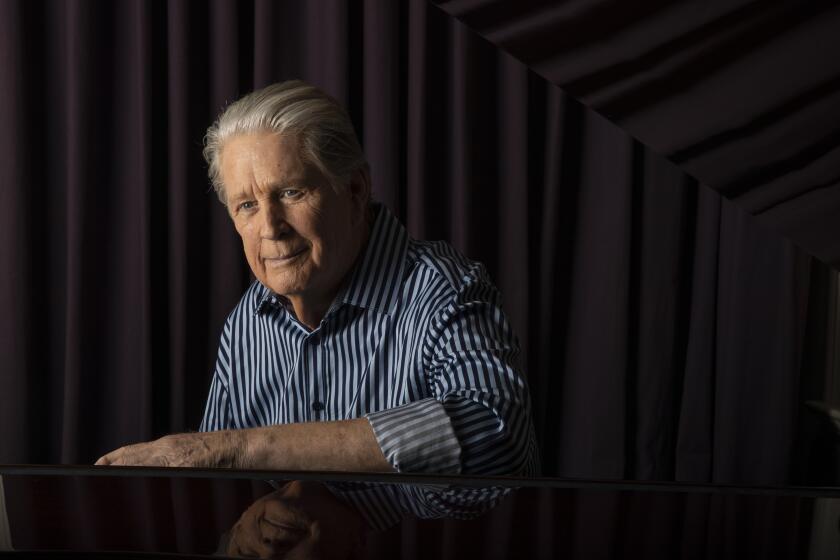Anime goes high-techno
- Share via
The new Japanese animation film “Appleseed” has fans buzzing with anticipation not just over its groundbreaking visuals, but for an all-star soundtrack that features some of the biggest names in techno and electronic music.
Producer Fumihiko Sori wanted the post-apocalyptic tale of love and betrayal to achieve many firsts, among them being the first anime feature to use musicians of international standing, said Hana Tabata, who produced the soundtrack. Pioneering DJ and producer Paul Oakenfold contributed one track, as did fellow Britons Basement Jaxx, and the Japanese duo Boom Boom Satellites delivered four songs, including the main theme, “Dive for You.”
Conventional wisdom had been that using international artists would be too costly, Tabata said, but the “Appleseed” soundtrack turned out to be a labor of love for the musicians involved. When she put out feelers for who might be interested in working on the movie, she was amazed at how many were eager to add their urgent, frenetic beats to a story taken from a popular Japanese comic of the late 1980s.
“A lot of musicians are Japanese animation fans,” she said. “A lot of them raised their hands.” The movie opens Friday in Los Angeles, New York, Chicago, Miami and selected other cities.
For his part, Michiyuki Kawashima, singer and guitarist for the Boom Boom Satellites, said the “Appleseed” visuals and plot won him over.
“I like the story because it’s very simple, it’s right or wrong,” Kawashima said through an interpreter. “But it’s not only that, it’s the depth of the message inside the story. There is love, and what you live for, and each character makes me think, ‘What is that?’ ”
The story, set in 2131, follows a female guerrilla named Deunan Knute, who is still fighting a global war she doesn’t know has ended until she’s plucked from the middle of a firefight and transported to a utopian metropolis, Olympus. There, she finds that a ruling committee of elders and a massive supercomputer are overseeing a worldwide truce. She also discovers that her long-lost lover and fellow soldier, Briareos, has been repaired as a part-human cyborg after being critically wounded in battle.
The population of Olympus is half human and half “bioroid” -- an engineered race of beings with abridged emotions, created to dilute the influence of hotheaded humans and thus maintain peace in society. In this arrangement, humans control the army and bioroids control the government, with neither side trusting the other. Deunan discovers that her past plays a major role in this delicate balance, and is thrust into a fight to preserve it and prevent genocide.
The love story between Deunan and Briareos -- a futuristic beauty-and-the-beast tale -- and the fight between good and evil are familiar themes that even newcomers to Japanese animation will recognize, Tabata said.
Underlying those, however, are deeper questions on the fate and even meaning of humanity, which it is hoped will attract fans of the more dense and cerebral plots typical of many anime films, said Mark Roche, vice president of marketing and publicity for the film’s American distributor, Long Beach-based Geneon Entertainment.
“Like most anime, it is extremely multilayered. It has much more depth than most American animation,” he said.
“Ultimately, what everyone can relate to is the love story between Briareos and Deunan,” Roche said.
It’s not surprising, considering Sori’s background as a visual effects supervisor on “Titanic,” but the look of the film is another area in which he wanted “Appleseed” to stand apart.
The movie used live actors and motion-capture technology to give the animated characters realistic movement. In addition, the 3-D computer-generated graphics were softened with a process called “toon shading,” to give them the look of traditional two-dimensional animation-cel images.
Tabata said that in Japan, where the movie has already been released, some fans of Boom Boom Satellites went to see “Appleseed” just because they craved new songs from their favorite band, even if they weren’t necessarily interested in the film.
The consensus of the feedback, she said, was that viewers came away impressed with what they saw on screen, not just what they heard.
Though fans of the music might be won over by the animation, or vice versa, Kawashima said he believed techno and anime shared many of the same devotees. So wedding the two art forms in one movie seemed only natural.
“I think they’re connecting each other,” he said. “Electronic music uses computers to make music, and that’s very futuristic.
“With electronica, just one person makes music, everything by himself. That means one person can control every instrument -- one person can control the world,” he said. “That image is more like science fiction. It’s very futuristic to me.”
Geneon Entertainment is highlighting the music as a major part of its marketing plan for “Appleseed,” which heavily targets colleges and the Internet.
“It’s a great soundtrack and it fits the movie beautifully,” said Roche, who agreed that there’s much crossover between fans of anime and techno. “They’re early trend adapters. They tend to be younger and into more fantasy. It’s very fantasy-oriented, very current.”
But -- as Tabata recounted in Japan -- Roche also expects that the music will be enough to draw in viewers who aren’t necessarily fans of Japanese animation, to see why it would attract some of the biggest names in techno. The soundtrack also includes German electro-punk artist T. Raumschmiere, Detroit techno leader Carl Craig, Japanese electronic music veteran Ryuichi Sakamoto and Canadian remix outfit Akufen.
“Anybody who’s not a bona fide anime fan would have a definite curiosity about what the project entails, and what’s so unique about it,” Roche said.
More to Read
The biggest entertainment stories
Get our big stories about Hollywood, film, television, music, arts, culture and more right in your inbox as soon as they publish.
You may occasionally receive promotional content from the Los Angeles Times.










